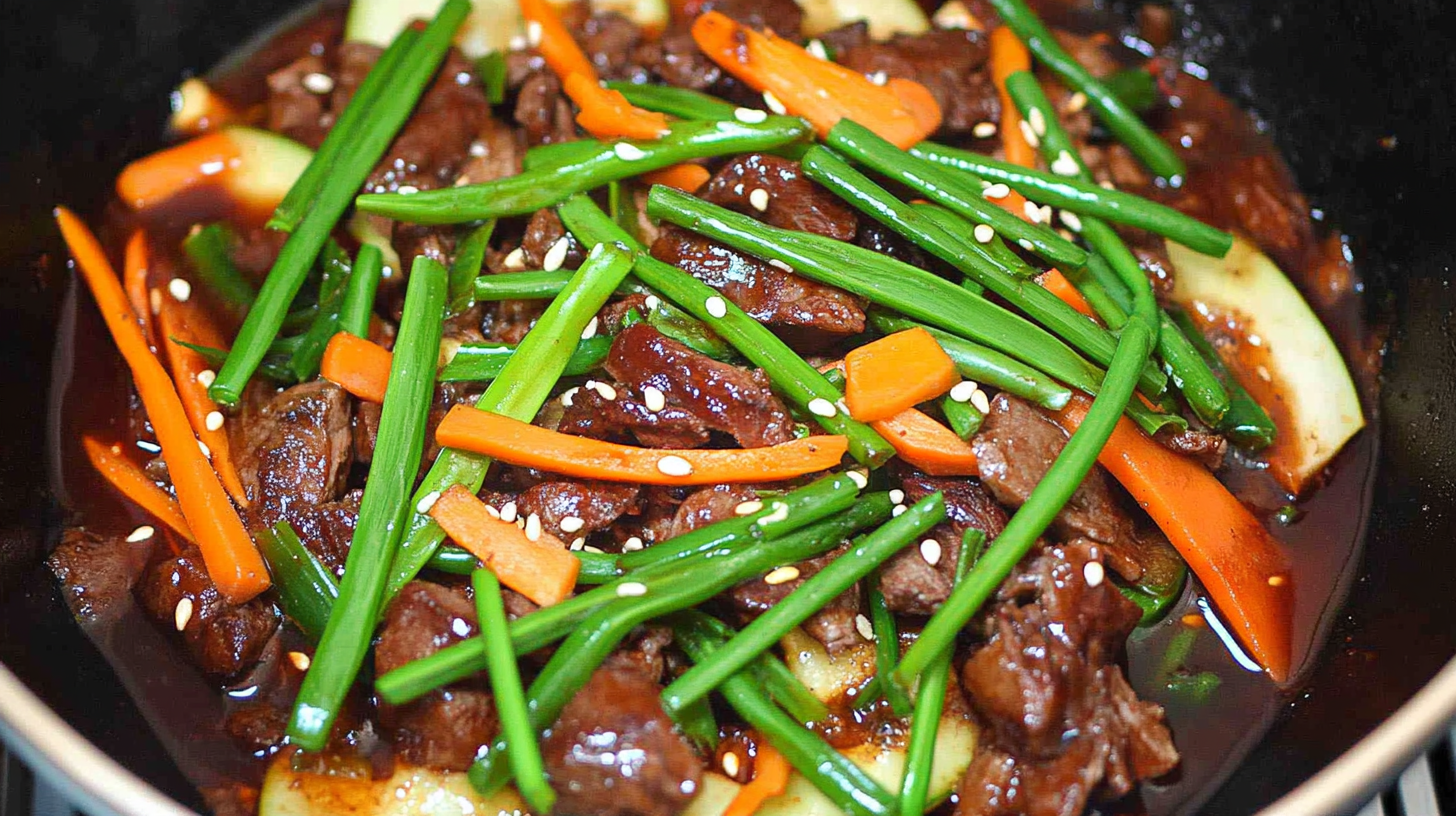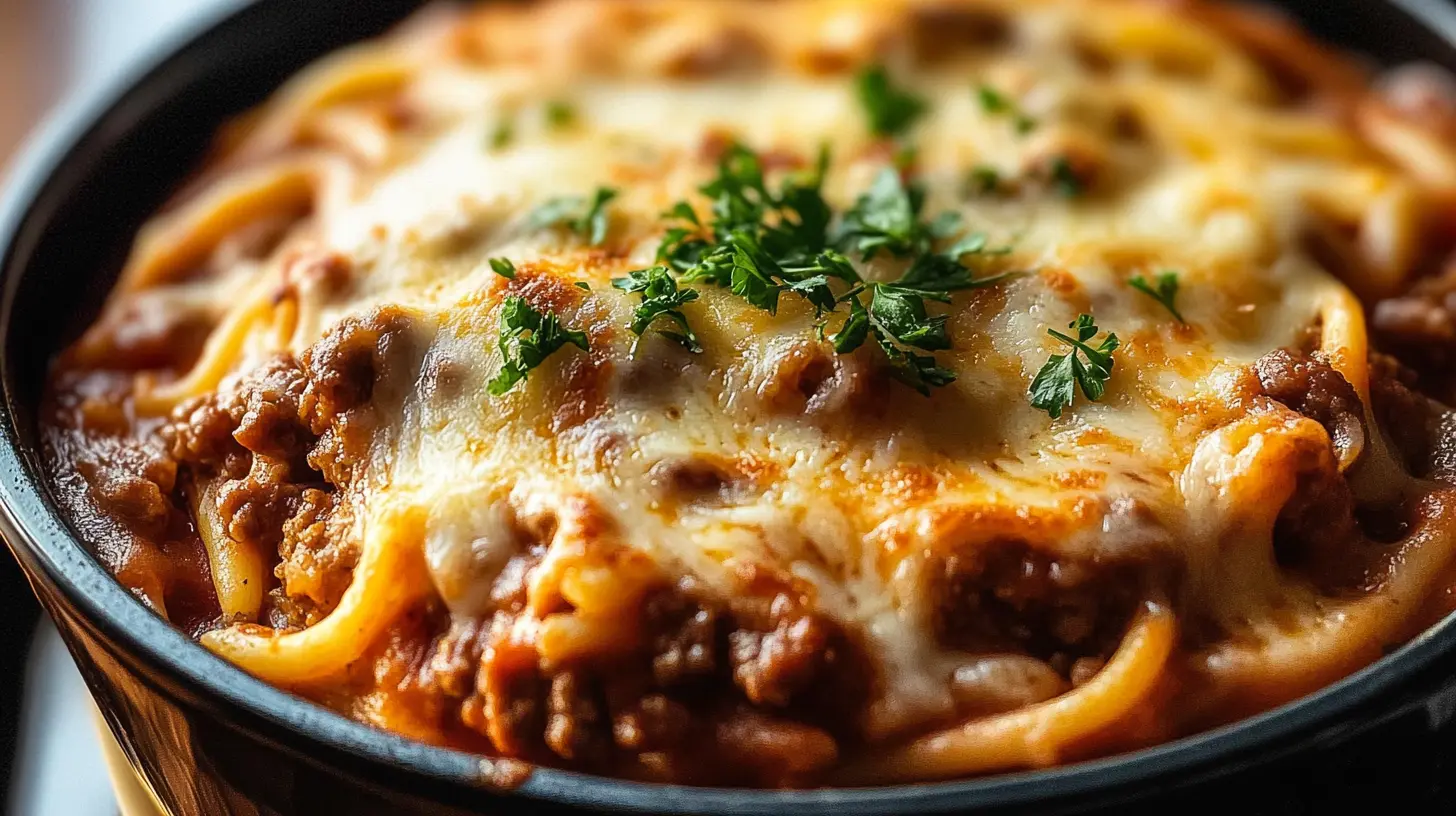Introduction to Mongolian BBQ Recipe
If you’re looking for a healthy, customizable, and flavorful dish, this Mongolian BBQ recipe is perfect for you. Mongolian BBQ isn’t your typical BBQ. Despite the name, it’s actually a stir-fry dish where you get to choose your favorite vegetables, proteins, and sauces, and have them cooked together in one quick, delicious meal. Originating from Taiwan and popularized around the world, this cooking style brings the joy of interactive cooking right into your kitchen.
Whether you’re a home cook, a busy parent, a student, or even a food enthusiast, Mongolian BBQ is a simple yet satisfying dish that can be tailored to suit any dietary needs. It’s naturally adaptable to low-carb, gluten-free, and vegan diets, making it perfect for anyone, no matter their dietary preferences.
For more delicious meal inspiration, check out our Korean BBQ Recipe, another fantastic option for grilling enthusiasts.
Benefits and Advantages of Mongolian BBQ Recipe
1. Healthy and Nutritious
Mongolian BBQ is loaded with fresh vegetables, lean proteins, and flavorful sauces, making it a nutrient-dense option. You can choose your own ingredients, ensuring you’re getting the right balance of protein, fiber, and healthy fats. Plus, stir-frying retains the nutrients of vegetables without adding excess fat or calories.
2. Customizable for Any Dietary Need
One of the best things about Mongolian BBQ is how easy it is to customize. Whether you’re vegan, gluten-free, or following a low-carb diet, you can adapt the recipe to meet your needs. Simply swap out ingredients, like using tofu instead of meat or gluten-free soy sauce, and you’ll have a dish that aligns with your preferences.
3. Quick and Easy to Prepare
Even with multiple ingredients, Mongolian BBQ is incredibly fast to cook. The actual cooking process takes less than 10 minutes, making it perfect for weeknights when time is limited. You can also prepare the ingredients in advance, saving even more time during the week.
Want to try another quick, nutrient-dense recipe? Check out this Caesar Pasta Salad for a light and refreshing option.
Ingredients Overview
Essential Ingredients for Mongolian BBQ Recipe
To make a delicious Mongolian BBQ at home, you’ll need the following essential ingredients:
- Protein: You can use chicken, beef, pork, tofu, or seafood like shrimp or scallops. Choose lean cuts of meat to keep the dish healthy.
- Vegetables: Include a variety of vegetables like broccoli, bell peppers, onions, mushrooms, and cabbage. The more colorful, the better!
- Noodles or Rice: Traditionally served over rice or noodles. Opt for whole-grain rice or zoodles (zucchini noodles) for a low-carb version.
- Mongolian Sauce: A combination of soy sauce, garlic, ginger, hoisin sauce, and a touch of sugar or honey to balance out the flavors.
- Cooking Oil: Use sesame oil for authentic Asian flavor or olive oil for a lighter option.
Vegan, Gluten-Free, and Low-Calorie Options
- Vegan: Replace meat with tofu, tempeh, or extra vegetables. Ensure the sauce is free from animal products by using vegan hoisin and soy sauce.
- Gluten-Free: Use gluten-free soy sauce or tamari and ensure any store-bought sauces are labeled gluten-free.
- Low-Calorie: Opt for lean proteins like chicken or shrimp and load up on fiber-rich vegetables. You can also use zoodles or cauliflower rice to cut down on calories from grains.
Dietary Substitutions to Customize Your Mongolian BBQ Recipe
- Low-Carb: Swap out rice or noodles for cauliflower rice or zoodles. You can also reduce the sugar content in the sauce by using a sugar substitute like stevia.
- Dairy-Free: Mongolian BBQ is naturally dairy-free, making it suitable for those avoiding dairy products.
- Nut-Free: If you have a nut allergy, make sure to use nut-free sauces and avoid garnishing with peanuts or cashews.
How to Prepare the Perfect Mongolian BBQ Recipe: Step-by-Step Guide
Making Mongolian BBQ at home is easy with these step-by-step instructions:
Step 1: Prepare the Protein
Slice your protein thinly to allow it to cook quickly. If using meat, consider freezing it for 10-15 minutes beforehand, which makes slicing easier.
Step 2: Prepare the Vegetables
Chop a variety of vegetables into bite-sized pieces. Aim for a colorful mix to ensure a variety of flavors and textures.
Step 3: Make the Sauce
In a bowl, whisk together soy sauce, hoisin sauce, garlic, ginger, and a little bit of sugar or honey. For a spicier version, add a pinch of chili flakes or Sriracha.
Step 4: Stir-Fry the Ingredients
Heat a large skillet or wok over high heat. Add a little oil and stir-fry the protein first until it’s browned. Remove the protein from the pan and stir-fry the vegetables until they’re crisp-tender.
Step 5: Combine and Cook
Return the protein to the pan, pour the sauce over the ingredients, and stir-fry for another 2-3 minutes until everything is evenly coated and cooked through.
Step 6: Serve
Serve the Mongolian BBQ over rice or noodles, or enjoy it with a low-carb base like zoodles or cauliflower rice. Garnish with sesame seeds or sliced green onions for added texture.
Mastering Mongolian BBQ Recipe: Advanced Tips and Variations
Want to take your Mongolian BBQ recipe to the next level? Here are a few advanced tips:
- Marinate the Protein: For extra flavor, marinate the protein in soy sauce, garlic, and ginger for 30 minutes before cooking.
- Caramelize the Sauce: Let the sauce cook down for an extra minute or two, allowing it to thicken and coat the ingredients with a rich, caramelized flavor.
- Try Different Proteins: Experiment with different proteins like lamb, duck, or even bison for a unique twist on the classic recipe.
How to Store Mongolian BBQ: Best Practices
Mongolian BBQ is best enjoyed fresh, but it stores well for later meals. Here’s how to store it:
- Refrigeration: Store leftovers in an airtight container in the fridge for up to 3 days. To reheat, simply stir-fry in a pan with a little water or oil to bring it back to life.
- Freezing: You can freeze Mongolian BBQ by placing it in a freezer-safe container or bag. It will last up to 3 months in the freezer. When ready to eat, thaw it in the fridge overnight and reheat in a pan.
Nutritional Value of Mongolian BBQ Recipe
The nutritional value of Mongolian BBQ will vary depending on the ingredients used, but here’s a general breakdown for one serving:
- Calories: 400
- Protein: 25g
- Fat: 15g
- Carbohydrates: 40g
- Fiber: 5g
For a lighter version, opt for lean proteins and cut down on high-calorie ingredients like sugar or oil.
FAQs: Frequently Asked Questions About Mongolian BBQ Recipe
Can I prepare Mongolian BBQ in advance?
Yes! You can chop the vegetables and marinate the protein a day in advance. When ready to cook, everything will come together in under 10 minutes.
Is Mongolian BBQ gluten-free?
Mongolian BBQ can be gluten-free as long as you use gluten-free soy sauce and hoisin sauce. Double-check any pre-made sauces for gluten-containing ingredients.
Can I freeze Mongolian BBQ?
Yes, Mongolian BBQ freezes well. Store it in an airtight container and thaw it in the fridge before reheating.
For more exciting BBQ recipes, don’t forget to try our Japanese BBQ Sauce Recipe for a tangy, umami-packed alternative!
What is Mongolian barbecue sauce made of?
Mongolian barbecue sauce typically consists of a savory and slightly sweet mixture of ingredients like soy sauce, hoisin sauce, garlic, ginger, sugar or honey, and sometimes sesame oil. Some recipes also include rice vinegar or chili flakes for added tang and heat. The sauce balances salty, sweet, and umami flavors, which coat the stir-fried meats and vegetables in Mongolian BBQ dishes.
For a more traditional touch, some variations might include oyster sauce or Chinese five-spice powder, which gives it a richer flavor. The sauce is quick to prepare and acts as the main flavor component for Mongolian barbecue.
To learn more about soy sauce and its varieties, you can check the Wikipedia page on soy sauce.
What is a Mongolian BBQ?
Mongolian BBQ, despite its name, is not an actual traditional Mongolian dish. Instead, it was created in Taiwan in the 1950s. It’s a stir-fry dish where diners select raw ingredients—such as various meats, vegetables, noodles, and sauces—and then have them cooked on a large, round, and extremely hot grill. The concept of “build-your-own” stir-fry truly lies at the heart of Mongolian BBQ, allowing each diner to fully customize their meal entirely based on personal preferences.
Additionally, this cooking style not only mimics the communal grilling experience of traditional Mongolian nomads, but it has also adapted to suit modern restaurant practices. Furthermore, Mongolian BBQ is well-known for being quick, fresh, and incredibly adaptable to many dietary restrictions, which makes it popular with diners of all preferences.
What kind of noodles are used in Mongolian BBQ?
Mongolian BBQ typically features lo mein or yakisoba noodles, both of which are wheat-based and have a chewy texture that holds up well when stir-fried. Additionally, these noodles effectively absorb the savory sauce and pair perfectly with the stir-fried meats and vegetables, ensuring a flavorful and satisfying dish.
For those who are following a gluten-free or low-carb diet, you can easily substitute zucchini noodles (zoodles) or rice noodles. This substitution helps keep the dish light while still maintaining its delicious and flavorful base, ensuring that everyone can enjoy it, regardless of dietary preferences.
What kind of meat is in Mongolian barbecue?
Mongolian barbecue usually features a variety of thinly sliced meats, including beef, chicken, pork, lamb, and shrimp. These meats are typically lean and cut into small, thin slices to ensure quick cooking on the grill. Beef, particularly flank steak or sirloin, is one of the most popular choices because it absorbs the sauce beautifully and stays tender when stir-fried.
For a more authentic experience, some restaurants may also offer lamb, which boasts a more pronounced flavor that pairs well with the rich Mongolian sauce.
How authentic is Mongolian BBQ?
Despite its name, Mongolian BBQ is not an authentic Mongolian dish. It was invented in Taiwan in the 1950s and has little to no connection to traditional Mongolian cuisine. The name “Mongolian” was likely used to evoke exoticism, but the dish itself is more influenced by Chinese stir-fry techniques and Japanese teppanyaki cooking methods.
While the cooking style is not authentically Mongolian, it incorporates the nomadic culture’s preference for communal meals and grilling, ultimately creating a fusion of flavors from various Asian cuisines.
Is Mongolian food healthy?
Traditional Mongolian food features simple yet nutritious ingredients, primarily consisting of meat (often lamb or beef), dairy products, and root vegetables. The nomadic lifestyle heavily influences Mongolian cuisine, making it rich in protein and fats, both of which are essential for surviving Mongolia’s harsh climate.
However, modern Mongolian BBQ in restaurants offers a highly customizable meal. You can make it very healthy by choosing lean meats, fresh vegetables, and by limiting sauces that are high in sugar or fat. This way, you can easily create a nutrient-dense dish packed with protein, fiber, and essential vitamins.
For more details about traditional Mongolian cuisine, feel free to visit the Wikipedia page on Mongolian cuisine.
What is Mongolian beef sauce made of?
Mongolian beef sauce typically combines soy sauce, hoisin sauce, garlic, ginger, and brown sugar or honey. Some recipes may also add rice vinegar or chili flakes to enhance the flavor. Cornstarch thickens the sauce, creating a rich, glossy coating for the beef.
The sweet, savory, and umami flavors in Mongolian beef sauce pair perfectly with beef, allowing the sauce to thoroughly absorb into the meat as it cooks, ultimately giving it a deep, caramelized flavor.
What is Genghis Khan BBQ?
Genghis Khan BBQ is a Japanese grilling dish, often mistaken for Mongolian BBQ. The dish involves grilling thin slices of meat, usually lamb or mutton, on a convex metal plate that resembles a helmet, believed to be inspired by the helmets worn by Mongolian warriors during the time of Genghis Khan.
Although the dish draws inspiration from the Mongolian nomadic lifestyle, it was created by the Japanese. Particularly popular in the Hokkaido region, it is a communal dish where diners grill the meat themselves and enjoy it with dipping sauces, rice, and vegetables.
Why is Mongolian meat good?
Mongolian meat, particularly lamb and beef, stands out for its rich flavor and high quality. The exceptional taste stems from the natural grazing of livestock. Mongolian sheep and cattle roam freely on vast, open grasslands, feeding on natural vegetation that is free from pesticides or chemicals. This natural diet, along with Mongolia’s harsh climate, results in leaner, more flavorful, and nutrient-dense meat.
Minimal intervention in raising these animals further adds to the purity and flavor of Mongolian meat, making it highly sought after.
Conclusion
Mongolian BBQ is a delightful fusion dish that blends a variety of meats, vegetables, and savory sauces into one irresistible meal. While not authentically Mongolian, its interactive, communal cooking style captures the essence of nomadic culture. With fresh ingredients and lean meats, Mongolian BBQ offers a flavorful and healthy option for diners. Whether you use traditional Mongolian beef sauce, lean meats, or flavorful noodles, you can easily customize this versatile dish to meet any dietary preferences.
For more information on traditional Mongolian dishes, you can explore Mongolian cuisine on Wikipedia.
This Mongolian BBQ recipe not only brings all the bold flavors of this beloved dish into your kitchen but also offers endless customization options to suit your dietary preferences. Whether you’re a beginner cook or a seasoned chef, Mongolian BBQ provides a fun, interactive, and engaging way to enjoy healthy, flavorful meals. Additionally, you can easily adapt the ingredients to cater to various diets, ensuring that every meal is both satisfying and tailored to your specific needs.




